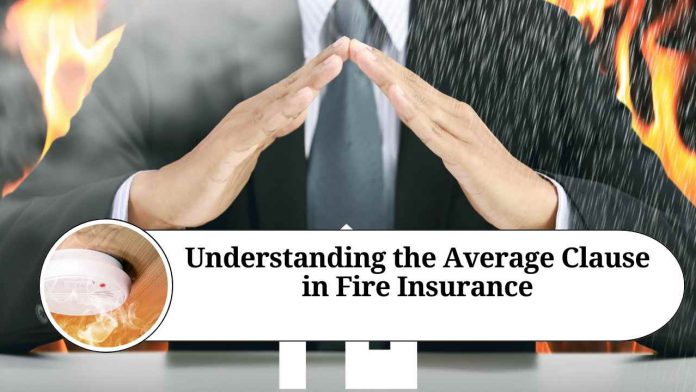Introduction
Fire insurance plays a crucial role in protecting individuals and businesses from the financial devastation caused by fires. However, when it comes to fire insurance policies, there is an important concept known as the average clause that policyholders should be aware of. In this blog post, we will delve into the average clause in fire insurance, explaining its purpose, how it works, and its significance for policyholders.
What is the Average Clause in Fire Insurance?
The average clause, also referred to as the “underinsurance clause” or “co-insurance clause,” is a provision commonly found in fire insurance policies. Its primary objective is to ensure that policyholders adequately insure their property to avoid potential financial loss in the event of a partial loss or damage caused by a fire.
Understanding the Purpose:
The purpose of the average clause is to encourage policyholders to insure their property for its full value rather than undervaluing it to reduce insurance premiums. By maintaining adequate coverage, policyholders can mitigate the risk of being underinsured and experiencing a shortfall when filing a claim.
How Does the Average Clause Work?
Under the average clause, the policyholder agrees to maintain a specific percentage of insurance coverage based on the property’s actual value. This percentage, known as the “coinsurance percentage,” is typically mentioned in the policy. It is crucial for policyholders to understand and meet this requirement to avoid potential penalties or reductions in claim settlements.
In the event of a partial loss or damage caused by a fire, the insurance company applies the average clause formula to determine the amount they will pay out. The formula is as follows:
Claim Amount = (Insurance Carried / Insurance Required) x Loss
The “Insurance Carried” refers to the actual amount of insurance coverage purchased by the policyholder, while the “Insurance Required” is the minimum amount of insurance that should have been carried (based on the coinsurance percentage). The resulting quotient is multiplied by the loss to determine the final claim amount.
Significance for Policyholders:
The average clause emphasizes the importance of accurately assessing and insuring the value of the property. Failing to meet the coinsurance percentage can result in a reduced claim settlement. For instance, if a policyholder insures their property for only 50% of its actual value but the coinsurance percentage mentioned in the policy is 80%, the policyholder will be considered underinsured. In such cases, if a fire damages the property, the claim payout will be significantly reduced.
To avoid being penalized by the average clause, policyholders should:
Assess the value of their property accurately:
It is crucial to obtain a professional appraisal or seek guidance from an insurance agent to determine the property’s actual value.
Maintain adequate insurance coverage:
Policyholders should ensure that they carry insurance coverage equal to or exceeding the required percentage mentioned in the policy.
Regularly review and update insurance policies:
As property values may change over time, it is essential to review and update insurance policies periodically to ensure adequate coverage.
Conclusion
The average clause is an important aspect of fire insurance policies that policyholders should understand. By comprehending its purpose and functioning, individuals and businesses can make informed decisions when insuring their property. Accurately assessing the value of the property and maintaining sufficient insurance coverage are crucial steps to mitigate the risk of being underinsured and to maximize the benefits of fire insurance in the event of a partial loss or damage caused by fire.
Read more useful content:
FAQs on Average Clause in Fire Insurance
Q1: What is the average clause in fire insurance?
A1: The average clause, also known as the “underinsurance clause” or “co-insurance clause,” is a provision in fire insurance policies that ensures policyholders maintain adequate insurance coverage for their property’s full value.
Q2: What is the purpose of the average clause?
A2: The average clause aims to prevent policyholders from undervaluing their property to reduce insurance premiums. It encourages them to insure their property adequately to avoid financial loss in the event of partial loss or damage caused by fire.
Q3: How does the average clause work?
A3: Under the average clause, policyholders agree to maintain a specific percentage of insurance coverage based on the property’s actual value. If a fire causes partial loss or damage, the claim payout is determined by the formula: Claim Amount = (Insurance Carried / Insurance Required) x Loss.
Q4: What is the coinsurance percentage?
A4: The coinsurance percentage is the minimum percentage of insurance coverage that policyholders must maintain based on the property’s value. It is mentioned in the insurance policy and varies from one policy to another.
Q5: What happens if I am underinsured according to the coinsurance percentage?
A5: If you are underinsured according to the coinsurance percentage, your claim payout will be reduced. The claim amount is calculated based on the ratio between the insurance carried and the insurance required, resulting in a proportionate reduction in the settlement.
Q6: How can I determine the insurance required for my property?
A6: To determine the insurance required, it is advisable to seek guidance from an insurance agent or obtain a professional appraisal. They can help assess the property’s actual value and calculate the appropriate insurance coverage.
Q7: Can the average clause apply to total losses as well?
A7: No, the average clause typically applies to partial losses or damage caused by fire. In the case of a total loss, where the property is completely destroyed, the average clause does not come into effect.
Q8: How can I avoid penalties or reductions in claim settlements due to the average clause?
A8: To avoid penalties or reductions, it is important to accurately assess the value of your property, maintain insurance coverage equal to or exceeding the required percentage, and regularly review and update your insurance policies to reflect any changes in property values.
Q9: Can the coinsurance percentage vary between insurance policies?
A9: Yes, the coinsurance percentage can vary depending on the insurance policy. It is essential to carefully read and understand the terms and conditions of your fire insurance policy to determine the specific coinsurance percentage that applies to your coverage.
Q10: Is the average clause exclusive to fire insurance policies?
A10: While the average clause is commonly associated with fire insurance, similar concepts may exist in other types of insurance policies as well, such as property insurance or business interruption insurance. It is important to review the specific terms and conditions of your insurance policy to understand the clauses and requirements applicable to your coverage.




















